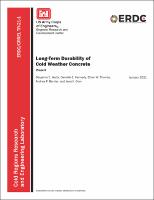Please use this identifier to cite or link to this item:
https://hdl.handle.net/11681/39579Full metadata record
| DC Field | Value | Language |
|---|---|---|
| dc.contributor.author | Watts, Benjamin E. | - |
| dc.contributor.author | Kennedy, Danielle E. | - |
| dc.contributor.author | Thomas, Ethan W. | - |
| dc.contributor.author | Bernier, Andrew P. | - |
| dc.contributor.author | Oren, Jared I. | - |
| dc.date.accessioned | 2021-01-26T22:36:03Z | - |
| dc.date.available | 2021-01-26T22:36:03Z | - |
| dc.date.issued | 2021-01 | - |
| dc.identifier.govdoc | ERDC/CRREL TR-21-1 | - |
| dc.identifier.uri | https://hdl.handle.net/11681/39579 | - |
| dc.identifier.uri | http://dx.doi.org/10.21079/11681/39579 | - |
| dc.description | Technical Report | en_US |
| dc.description.abstract | Recent laboratory results confirm that it is possible to protect concrete from freezing solely using chemical admixtures and indicate that the amount of admixture required may be significantly less than previously recommended. Researchers have also verified that admixture-based freeze protection can produce concrete that is durable to winter exposure for a minimum of 20 years, through petrographic examination of core specimens obtained from past field demonstrations. Freeze protection for concrete using chemical admixtures alone has been an area of active research for 3 decades; however, the most recent methodology recommends very high addition rates of accelerating and corrosion inhibiting admixtures, which result in significant challenges, including slump loss, rapid setting, and potentially excessive temperature rise. As part of a laboratory study, researchers systematically varied the dosage of freeze protection admixtures used in concrete cured in a 23 °F environment. Preliminary findings indicate that a 50% reduction in admixture dose maintained adequate freeze protection and resulted in compressive strengths exceeding those of room-temperature controls at 7 and 28 days. The combination of improved handling, reduced cost, and verified durability associated with the use of admixtures for freeze protection makes a compelling case for broader adoption of this technique in winter operations. | en_US |
| dc.description.sponsorship | Prepared for Headquarters, U.S. Army Corps of Engineers ; Under PE62784/T53, “Innovative Construction Materials for the Arctic Program.” | en_US |
| dc.format.extent | 97 pages/32.79 MB | - |
| dc.format.medium | - | |
| dc.language.iso | en_US | en_US |
| dc.publisher | Cold Regions Research and Engineering Laboratory (U.S.) | en_US |
| dc.publisher | Engineer Research and Development Center (U.S.) | - |
| dc.relation.ispartofseries | Technical Report (Engineer Research and Development Center (U.S.));no.ERDC/CRREL TR-21-1 | - |
| dc.rights | Approved for public release; distribution is unlimited | - |
| dc.source | This Digital Resources was created in Microsoft Word and Adobe Acrobat. | - |
| dc.subject | Concrete--Service life | en_US |
| dc.subject | Construction--Cold weather conditions | en_US |
| dc.subject | Concrete--Effect of temperature on Concrete--Additives | en_US |
| dc.title | Long-Term Durability of Cold Weather Concrete : Phase II | en_US |
| dc.type | Report | - |
| Appears in Collections: | Technical Report | |
Files in This Item:
| File | Description | Size | Format | |
|---|---|---|---|---|
| ERDC-CRREL TR-21-1.pdf | 32.79 MB | Adobe PDF |  View/Open |